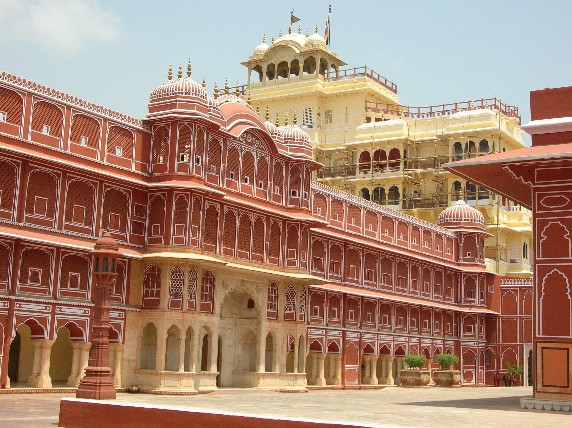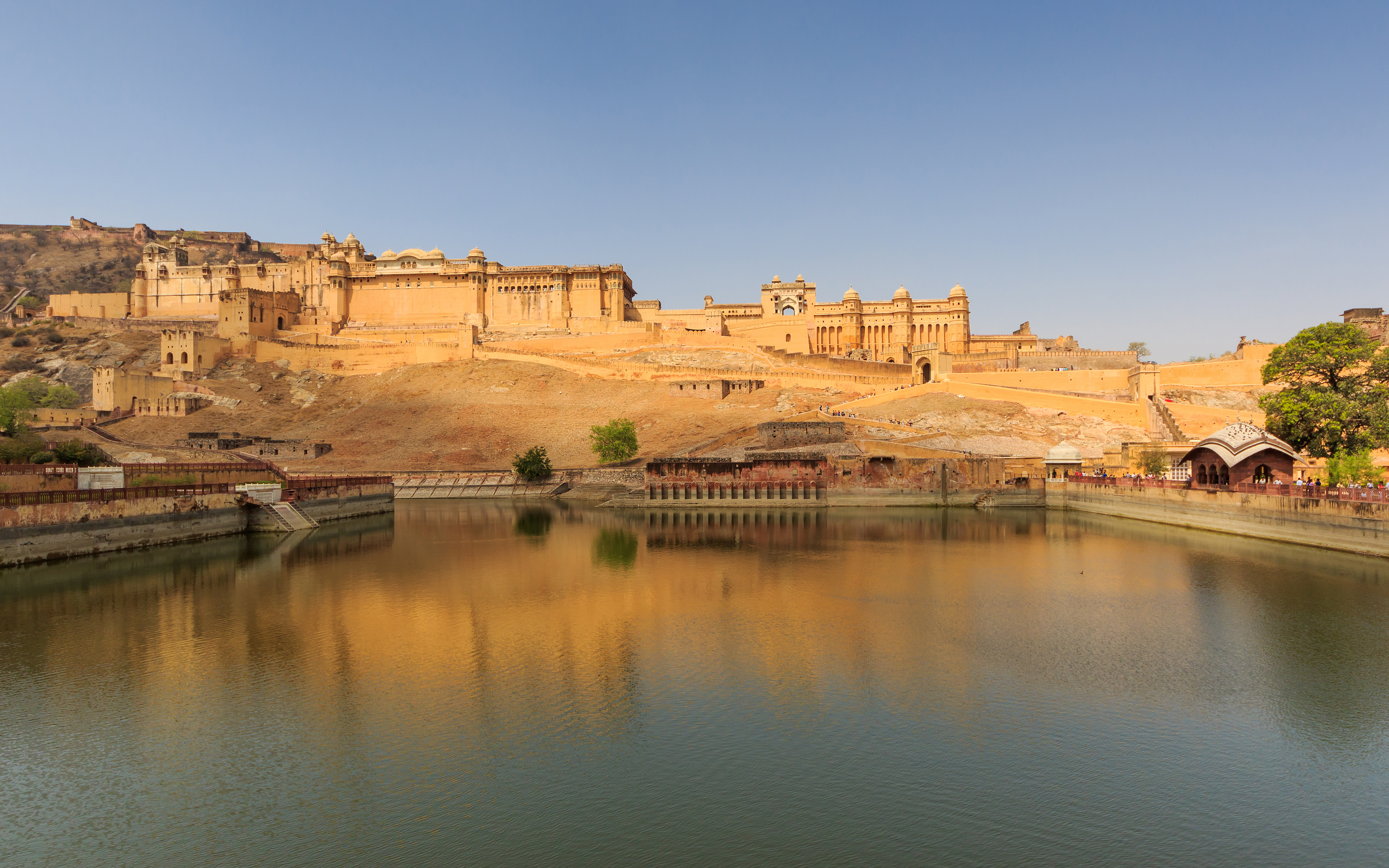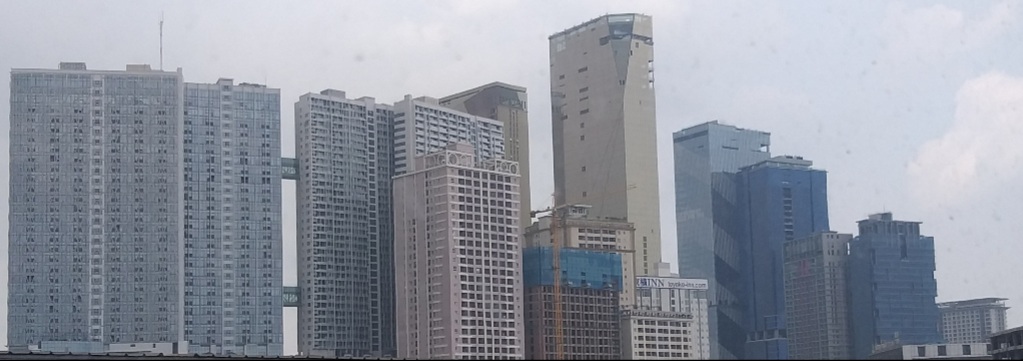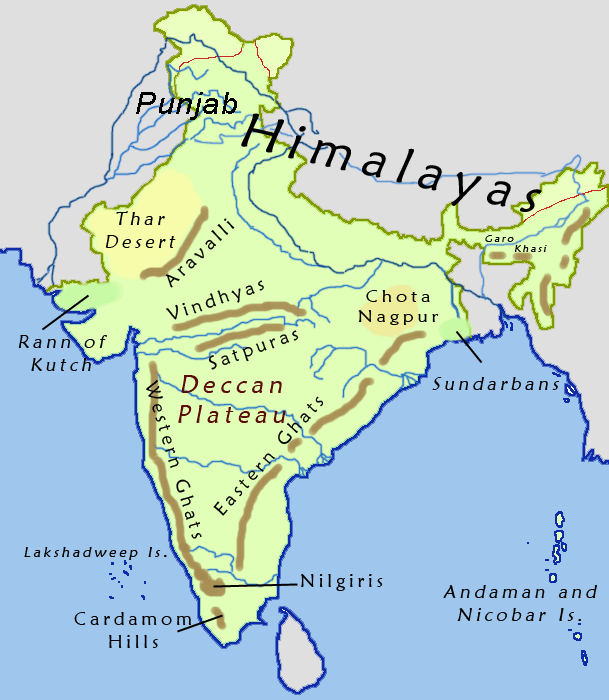|
Amer Fort
Amer Fort or Amber Fort is a fort located in Amer, Rajasthan, India. Amer is a town with an area of located from Jaipur, the capital of Rajasthan. Amber city and Amber fort were founded by ruler Alan Singh of Chanda dynasty of Meenas. Located high on a hill, it is the principal tourist attraction in Jaipur. Amer Fort is known for its artistic style elements. With its large ramparts and series of gates and cobbled paths, the fort overlooks Maota Lake, which is the main source of water for the Amer Palace. Amer Palace is great example of Rajput architecture. Some of its buildings and work have influence of Mughal architecture. Constructed of red sandstone and marble, the attractive, opulent palace is laid out on four levels, each with a courtyard. It consists of the Diwan-e-Aam, or "Hall of Public Audience", the Diwan-e-Khas, or "Hall of Private Audience", the Sheesh Mahal (mirror palace), or Jai Mandir, and the Sukh Niwas where a cool climate is artificially created by winds t ... [...More Info...] [...Related Items...] OR: [Wikipedia] [Google] [Baidu] |
Rajput Architecture
Rajput architecture is a architectural style notable for the forts and palaces of the many Rajput rulers, which are popular tourist attractions, many of the Rajput forts are UNESCO World Heritage Site. Rajput architecture represents different types of buildings, which may broadly be classed either as religious These include temples, forts, stepwells, gardens, and palaces. The forts were specially built for defense and military purposes. The Mughal architecture greatly influenced indigenous Rajput styles of art and architecture. Rajput architecture continued well into the 20th and 21st centuries, as the rulers of the princely states of British India commissioned vast palaces and other buildings, such as the Albert Hall Museum, Lalgarh Palace, and Umaid Bhawan Palace. These usually incorporated European styles as well, a practice which eventually led to the Indo-Saracenic style.Michell, George (1990), ''The Penguin Guide to the Monuments of India, Volume 1: Buddhist, Jai ... [...More Info...] [...Related Items...] OR: [Wikipedia] [Google] [Baidu] |
Hill Forts Of Rajasthan
The North Western Indian State of Rajasthan has over one hundred fortifications on hills and mountainous terrain. Six Hill Forts of Rajasthan, spread across Rajasthan state in northern India, have been clustered as a series and designated UNESCO World Heritage Site. The ‘Hill Forts of Rajasthan’ was initially submitted to the UNESCO as a serial property formed by five Rajput forts in the Aravalli Range, and were built and enhanced between the 5th and 18th centuries CE by several Rajput kings of different kingdoms. The UNESCO series has been increased to six forts. They consist of: # Chittor Fort at Chittorgarh city # Kumbhalgarh Fort at Rajsamand city # Ranthambore Fort at Sawai Madhopur # Gagron Fort at Jhalawar city # Amer Fort at Jaipur city # Jaisalmer Fort at Jaisalmer city Some of these forts have defensive fortification wall up to 20 km long, still surviving urban centers and still in use water harvesting mechanism. Selection A series was to be selected a ... [...More Info...] [...Related Items...] OR: [Wikipedia] [Google] [Baidu] |
Amer (India)
Amber or Amer, is a city near Jaipur, Jaipur city in Jaipur district in the Indian states and territories of India, state of Rajasthan. It is now a part of the Jaipur Municipal Corporation. The picturesque situation of Amber at the mouth of a rocky mountain gorge, in which nestles a lake, has attracted the admiration of travellers, including Victor Jacquemont and Reginald Heber. It is seen to be a remarkable example for its combined Rajput-Mughal architecture. The Amber Fort, a UNESCO World Heritage Site, is the top tourist attraction in the Jaipur area. History The state of Jaipur was earlier known as Amer, India, Amber or Dhundhar and was controlled by Meena chiefs of five different tribes who were under suzerainty of the Bargurjar Rajput Raja of Deoti. Later a Kachhwaha prince Dulha Rai destroyed the sovereignty of Meenas and also defeated Bargurjars of Deoli and took Dhundhar fully under Kachwaha rule. Much of the present structure known as Amber Fort is actually the pala ... [...More Info...] [...Related Items...] OR: [Wikipedia] [Google] [Baidu] |
Rajput
Rajput (from Sanskrit ''raja-putra'' 'son of a king') is a large multi-component cluster of castes, kin bodies, and local groups, sharing social status and ideology of genealogical descent originating from the Indian subcontinent. The term Rajput covers various patrilineal clans historically associated with warriorhood: several clans claim Rajput status, although not all claims are universally accepted. According to modern scholars, almost all Rajput clans originated from peasant or pastoral communities. Over time, the Rajputs emerged as a social class comprising people from a variety of ethnic and geographical backgrounds. During the 16th and 17th centuries, the membership of this class became largely hereditary, although new claims to Rajput status continued to be made in the later centuries. Several Rajput-ruled kingdoms played a significant role in many regions of central and northern India from seventh century onwards. The Rajput population and the former Rajput stat ... [...More Info...] [...Related Items...] OR: [Wikipedia] [Google] [Baidu] |
Shiva
Shiva (; sa, शिव, lit=The Auspicious One, Śiva ), also known as Mahadeva (; ɐɦaːd̪eːʋɐ, or Hara, is one of the principal deities of Hinduism. He is the Supreme Being in Shaivism, one of the major traditions within Hinduism. Shiva is known as "The Destroyer" within the Trimurti, the Hindu trinity which also includes Brahma and Vishnu. In the Shaivite tradition, Shiva is the Supreme Lord who creates, protects and transforms the universe. In the goddess-oriented Shakta tradition, the Supreme Goddess ( Devi) is regarded as the energy and creative power (Shakti) and the equal complementary partner of Shiva. Shiva is one of the five equivalent deities in Panchayatana puja of the Smarta tradition of Hinduism. Shiva has many aspects, benevolent as well as fearsome. In benevolent aspects, he is depicted as an omniscient Yogi who lives an ascetic life on Mount Kailash as well as a householder with his wife Parvati and his three children, Ganesha, Kartikeya and A ... [...More Info...] [...Related Items...] OR: [Wikipedia] [Google] [Baidu] |
The Hindu
''The Hindu'' is an Indian English-language daily newspaper owned by The Hindu Group, headquartered in Chennai, Tamil Nadu. It began as a weekly in 1878 and became a daily in 1889. It is one of the Indian newspapers of record and the second most circulated English-language newspaper in India, after '' The Times of India''. , ''The Hindu'' is published from 21 locations across 11 states of India. ''The Hindu'' has been a family-owned newspaper since 1905, when it was purchased by S. Kasturi Ranga Iyengar from the original founders. It is now jointly owned by Iyengar's descendants, referred to as the "Kasturi family", who serve as the directors of the holding company. The current chairperson of the group is Malini Parthasarathy, a great-granddaughter of Iyengar. Except for a period of about two years, when S. Varadarajan held the editorship of the newspaper, the editorial positions of the paper were always held by members of the family or held under their direction. Histo ... [...More Info...] [...Related Items...] OR: [Wikipedia] [Google] [Baidu] |
World Heritage Site
A World Heritage Site is a landmark or area with legal protection by an international convention administered by the United Nations Educational, Scientific and Cultural Organization (UNESCO). World Heritage Sites are designated by UNESCO for having cultural, historical, scientific or other form of significance. The sites are judged to contain " cultural and natural heritage around the world considered to be of outstanding value to humanity". To be selected, a World Heritage Site must be a somehow unique landmark which is geographically and historically identifiable and has special cultural or physical significance. For example, World Heritage Sites might be ancient ruins or historical structures, buildings, cities, deserts, forests, islands, lakes, monuments, mountains, or wilderness areas. A World Heritage Site may signify a remarkable accomplishment of humanity, and serve as evidence of our intellectual history on the planet, or it might be a place of great natural beauty. A ... [...More Info...] [...Related Items...] OR: [Wikipedia] [Google] [Baidu] |
Cambodia
Cambodia (; also Kampuchea ; km, កម្ពុជា, UNGEGN: ), officially the Kingdom of Cambodia, is a country located in the southern portion of the Indochinese Peninsula in Southeast Asia, spanning an area of , bordered by Thailand to the northwest, Laos to the north, Vietnam to the east, and the Gulf of Thailand to the southwest. The capital and largest city is Phnom Penh. The sovereign state of Cambodia has a population of over 17 million. Buddhism is enshrined in the constitution as the official state religion, and is practised by more than 97% of the population. Cambodia's minority groups include Vietnamese, Chinese, Chams and 30 hill tribes. Cambodia has a tropical monsoon climate of two seasons, and the country is made up of a central floodplain around the Tonlé Sap lake and Mekong Delta, surrounded by mountainous regions. The capital and largest city is Phnom Penh, the political, economic and cultural centre of Cambodia. The kingdom is an elective co ... [...More Info...] [...Related Items...] OR: [Wikipedia] [Google] [Baidu] |
Phnom Penh
Phnom Penh (; km, ភ្នំពេញ, ) is the capital and most populous city of Cambodia. It has been the national capital since the French protectorate of Cambodia and has grown to become the nation's primate city and its economic, industrial, and cultural centre. Phnom Penh succeeded Angkor Thom as the capital of the Khmer nation but was abandoned several times before being reestablished in 1865 by King Norodom. The city formerly functioned as a processing center, with textiles, pharmaceuticals, machine manufacturing, and rice milling. Its chief assets, however, were cultural. Institutions of higher learning included the Royal University of Phnom Penh (established in 1960 as Royal Khmer University), with schools of engineering, fine arts, technology, and agricultural sciences, the latter at Chamkar Daung, a suburb. Also located in Phnom Penh were the Royal University of Agronomic Sciences and the Agricultural School of Prek Leap. The city was nicknamed the "Pearl of As ... [...More Info...] [...Related Items...] OR: [Wikipedia] [Google] [Baidu] |
Aravalli Range
The Aravalli Range (also spelled ''Aravali'') is a mountain range in Northern-Western India, running approximately in a south-west direction, starting near Delhi, passing through southern Haryana, Rajasthan, and ending in Ahmedabad Gujarat. The highest peak is Guru Shikhar on Mount Abu at . The Aravalli Range is arguably the oldest geological feature on Earth, having its origin in the Proterozoic era. The Aravalli Range is rich in natural resources and serves as check to the growth of the western desert. Etymology Aravalli, a composite Sanskrit word from the roots ''"ara"'' and ''"vali"'', literally means the ''"line of peaks"''. Natural history Geology The Aravalli Range, an eroded stub of ancient mountains, is believed to be the oldest range of fold mountains in India.Roy, A. B. (1990). Evolution of the Precambrian crust of the Aravalli Range. Developments in Precambrian Geology, 8, 327–347. The natural history of the Aravalli Range dates back to times when ... [...More Info...] [...Related Items...] OR: [Wikipedia] [Google] [Baidu] |
Jaigarh Fort
Jaigarh Fort is situated on the promontory called the Cheel ka Teela (Hill of Eagles) of the Aravalli range; it overlooks the Amer Fort and the Maota Lake, near Amer in Jaipur, Rajasthan, India. The fort was built by Sawai Jai Singh in 1726 to protect the Amer Fort and its palace complex and was named after him. The fort, rugged and similar in structural design to the Amer Fort, is also known as Victory Fort. It has a length of along the north–south direction and a width of . The fort features a cannon named "Jaivana" ( Jaivana Cannon), which was manufactured in the fort precincts and was then the world's largest cannon on wheels. Jaigarh Fort and Amer Fort are connected by subterranean passages and considered as one complex. Geography The Jaigarh Fort, located on one of the peaks of the Aravalli range of hills is built about 400 m above the Amer Fort. It provides an excellent of view of Aravalli hills and the Amer Fort down below. The fort is away from Jaipur city. It s ... [...More Info...] [...Related Items...] OR: [Wikipedia] [Google] [Baidu] |
Bangladesh
Bangladesh (}, ), officially the People's Republic of Bangladesh, is a country in South Asia. It is the eighth-most populous country in the world, with a population exceeding 165 million people in an area of . Bangladesh is among the most densely populated countries in the world, and shares land borders with India to the west, north, and east, and Myanmar to the southeast; to the south it has a coastline along the Bay of Bengal. It is narrowly separated from Bhutan and Nepal by the Siliguri Corridor; and from China by the Indian state of Sikkim in the north. Dhaka, the capital and largest city, is the nation's political, financial and cultural centre. Chittagong, the second-largest city, is the busiest port on the Bay of Bengal. The official language is Bengali, one of the easternmost branches of the Indo-European language family. Bangladesh forms the sovereign part of the historic and ethnolinguistic region of Bengal, which was divided during the Partition of India in ... [...More Info...] [...Related Items...] OR: [Wikipedia] [Google] [Baidu] |







